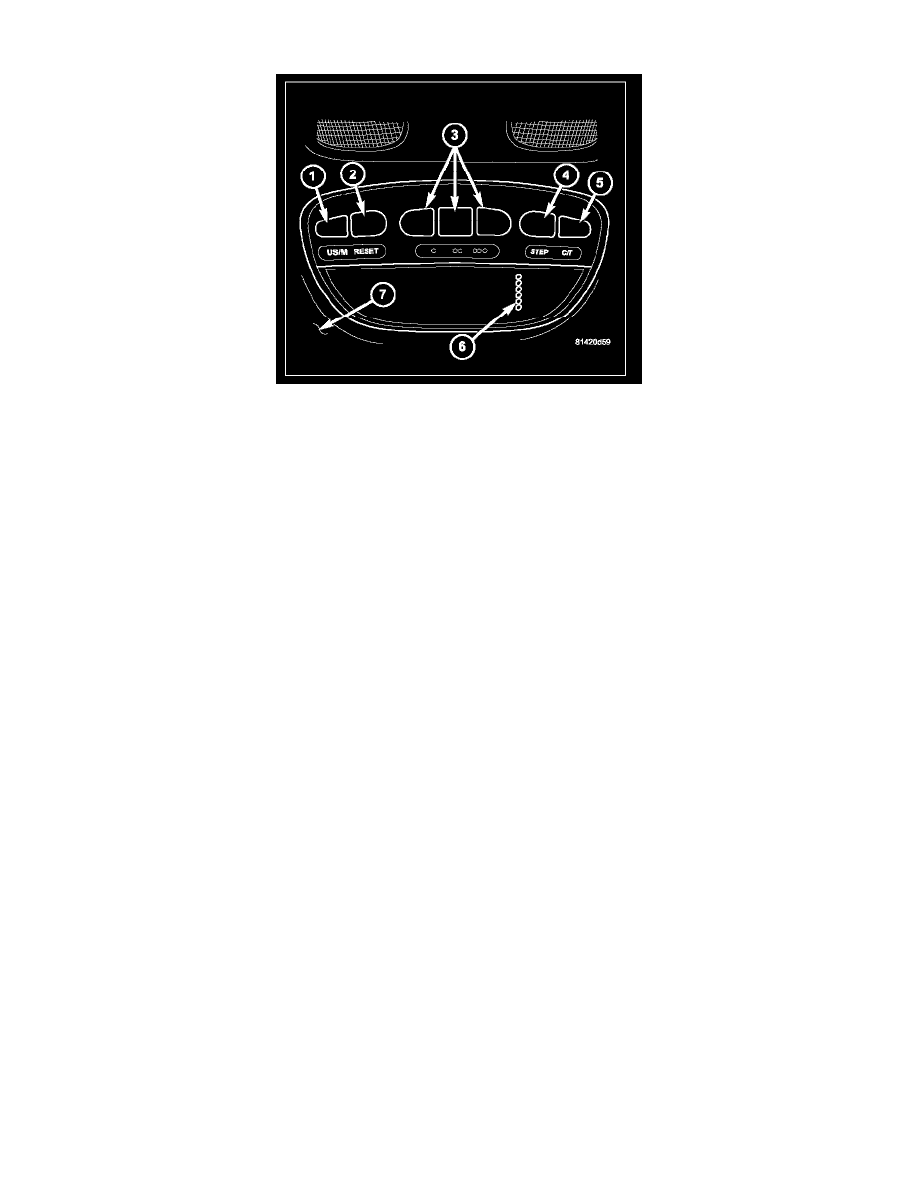RAM 1500 Truck 2WD V8-5.7L VIN 2 (2006)

Compass: Description and Operation
The Electronic Overhead Module (EOM) is located in the overhead console (7) and consists of the following components:
-
Compass mini-trip computer (on vehicles equipped with this option)
-
Vacuum-Fluorescent Display (VFD) (6)
-
Push button function switches (1, 2, 3, 4 and 5)
The EOM contains a central processing unit and interfaces with other electronic modules in the vehicle on the Controller Area Network (CAN) data bus.
The CAN data bus allows the sharing of sensor information. This helps to reduce wire harness complexity, reduce internal controller hardware, and
reduce component sensor current loads. At the same time, this system provides increased reliability, enhanced diagnostics, and allows the addition of
many new feature capabilities. If any of the components of the EOM are damaged or inoperative the entire EOM must be replaced,.
The EOM provides several electronic functions and features. Some of the functions and features that the EOM supports and/or controls, include the
following display options:
-
Compass and temperature - provides the outside temperature and one of eight compass readings to indicate the direction the vehicle is facing.
-
Trip odometer (TRIP ODO) - shows the distance travelled since the last trip computer reset.
-
Average fuel economy (AVG ECO) - shows the average fuel economy since the last trip computer reset.
-
Distance to empty (DTE) - shows the estimated distance that can be travelled with the fuel remaining in the fuel tank. This estimated distance is
computed using the level of the fuel in the tank and a weighted average of long term and recent Average Fuel Economy.
-
Elapsed time (ET) - shows the accumulated ignition-on time since the last trip computer reset.
-
Blank screen - the compass mini-trip VFD is turned off or in Blank Screen Mode.
The ambient temperature sensor is hard wired to the Front Control Module (FCM). The instrument cluster, also known as the Cab Compartment Node
(CCN) averages and filters the ambient temperature signal and supplies it to other modules on the CAN data bus. Data input for all other compass
mini-trip computer functions, including VFD dimming level, is received through CAN data bus messages. The maximum temperature displayed is 66° C
(140° F). It could take several miles for the accurate temperature to be displayed as the CCN filters out heat from the engine compartment.
The EOM uses its internal programming and all of these inputs to calculate and display the requested data. If the data displayed is incorrect, perform the
self-diagnostic tests as described. If these tests prove inconclusive, the use of a scan tool and the proper Diagnostic Procedures Information are
recommended for further testing of the EOM and the CAN data bus.
The EOM cannot be repaired, and is available for service only as a unit. This unit includes the push button switches, the Universal Garage Door
Transmitter and the plastic module and display lens. If any of these components is inoperative or damaged, the complete EOM must be replaced.
COMPASS
NOTE: If the compass functions, but accuracy is suspect, it may be necessary to perform a variation adjustment. This procedure allows the compass
unit to accommodate variations in the earth's magnetic field strength, based on geographic location.
While in the compass/temperature mode, the compass will display the direction in which the vehicle is pointed using the eight major compass headings
(Examples: north is N, northeast is NE). The self-calibrating compass unit requires no adjusting in normal use. The only calibration that may prove
necessary is to drive the vehicle in one or two complete circles, on level ground, in not less than 16 seconds. This will reorient the compass unit to its
vehicle.
The compass unit also will compensate for magnetism the body of the vehicle may acquire during normal use. However, avoid placing anything magnetic
directly on the roof of the vehicle. Magnetic mounts for an antenna, a repair order hat, or a funeral procession flag can exceed the compensating ability
